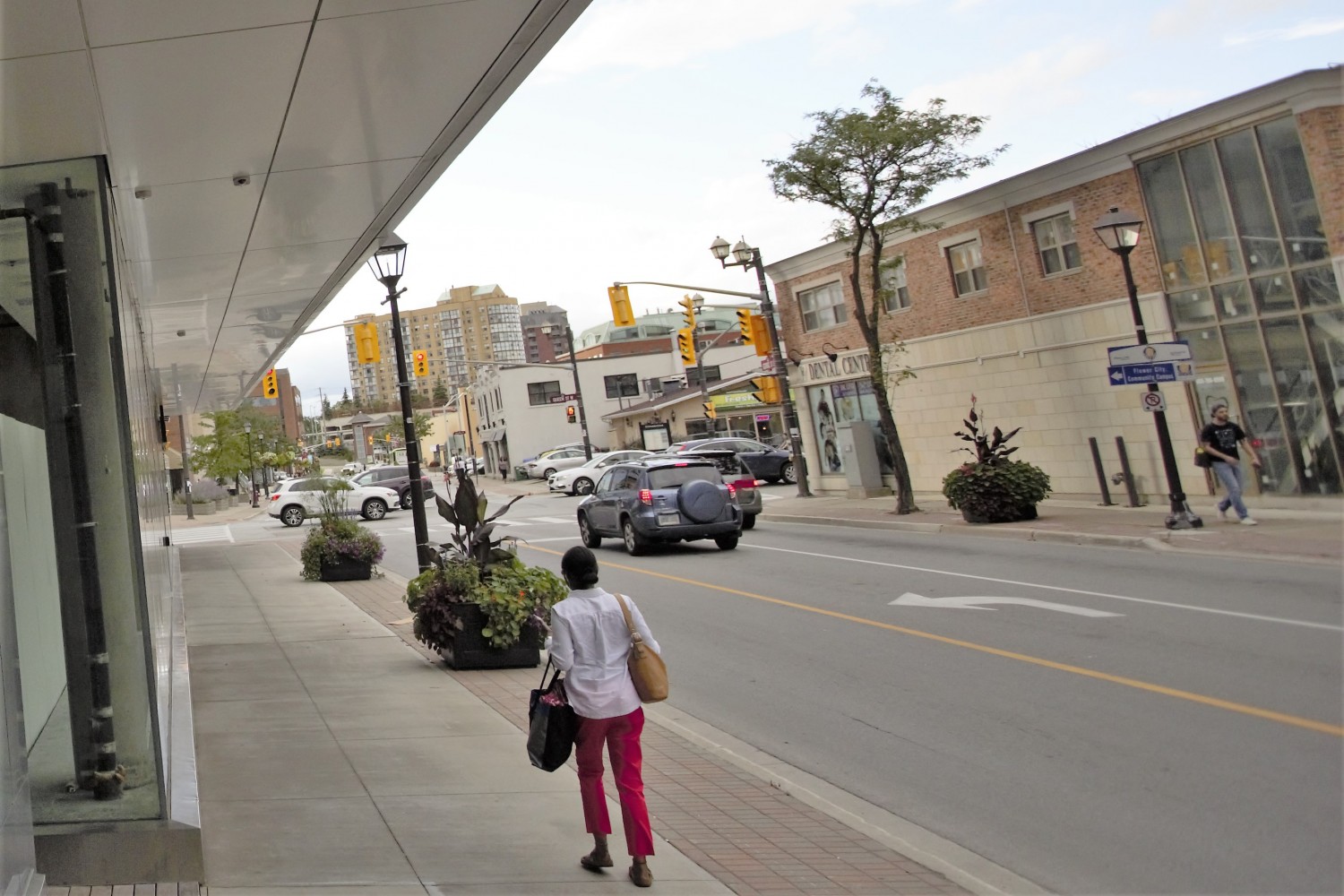
Watershed for downtown retailers desperate for plan to remake the city-centre
When Ken Greenberg first looked at the Gardiner Expressway in Toronto, he didn’t see a jarring example of urban blight. He saw an organic opportunity to link people to their neighbourhoods.
When he took a walking tour of Brampton in the spring of 2012 and delivered the keynote address at the annual general meeting of the now defunct Brampton Downtown Development Corporation (BDDC), he didn’t see boarded up storefronts and a downtown in decline, but a city of “remarkable assets” with good bone structure and a chance to be great.
The ideal, he said, was for cities to create “complete streets” that are not simply roadways to get cars from point A to point B, they are spaces used by pedestrians and cyclists too, with green features and sidewalk cafes, boutiques, offices and urban art and anything else planners can create to turn an ordinary stretch of city blocks into more of a destination that can also be travelled through. Brampton, he said, was on the cusp of radical change.
Greenberg wasn’t being naïve, or kind to his hosts, or the eternal optimist. As one of Canada’s most experienced urbanologists, he led the charge to rejuvenate urban eyesores from Toronto to Amsterdam. He is known around the world for his lectures, writing and urban planning work on four continents.
The New York-born urbanist, teacher and former director of urban design and architecture for the City of Toronto, has now, in his later years, produced one of the best rejuvenation projects in the world. In 2015, he walked into Toronto mayor John Tory’s office with philanthropists Judy and Wil Matthews and presented a plan to transform the 1.75-kilometre stretch of empty and overlooked land underneath the loathed Gardiner Expressway. He envisioned a vast urban park, knitting the lands with an open-amphitheatre, gardens, and a much-anticipated skating trail. It was opened in 2018 and has given thousands of people who moved into the Spadina Avenue-Dufferin Street area (Liberty Village), a much-needed urban playpen. Expanding the plan will continue unabated.
“The Bentway” is now part of the High Line Network – international projects that transform underutilized land into vibrant communities.
In Brampton, when he delivered his inspirational speech at the Rose Theatre, one of the spectators was Herman Custodio, a member of the BDDC board, and owner of Custodio’s Photography Studio (53 Main Street North), a long-time business in the downtown core. He was so impressed by Greenberg, he followed him to Toronto to hear him talk about how cities can “reimagine” themselves.

Herman Custodio
It’s that very term that now threatens Brampton’s future prospects.
It’s early afternoon on the second day of 2019, and Custodio is standing near the front door of his 2,500-square-foot studio, discussing this city’s watershed moment with The Pointer. His young daughter is in the background, playing on the computer, and enjoying her last days before returning to school next week.
It’s her future, and those of other young people in the city, that has Custodio concerned. In the final days of 2018, word came down that Brampton’s Downtown Reimagined project was being stopped because of the unknown costs attributed to the serious infrastructure problems in the subterranean water channels running underneath Main Street, located only a few feet below where he stood.
The extensive $33 million project to fix ageing regional water and sewer lines (which could cost businesses tens of millions if they burst) was also a catalyst to revitalize the streetscapes above, the beginning of the plan to create impressive “complete streets” and a new, vibrant downtown that would once again be a destination.
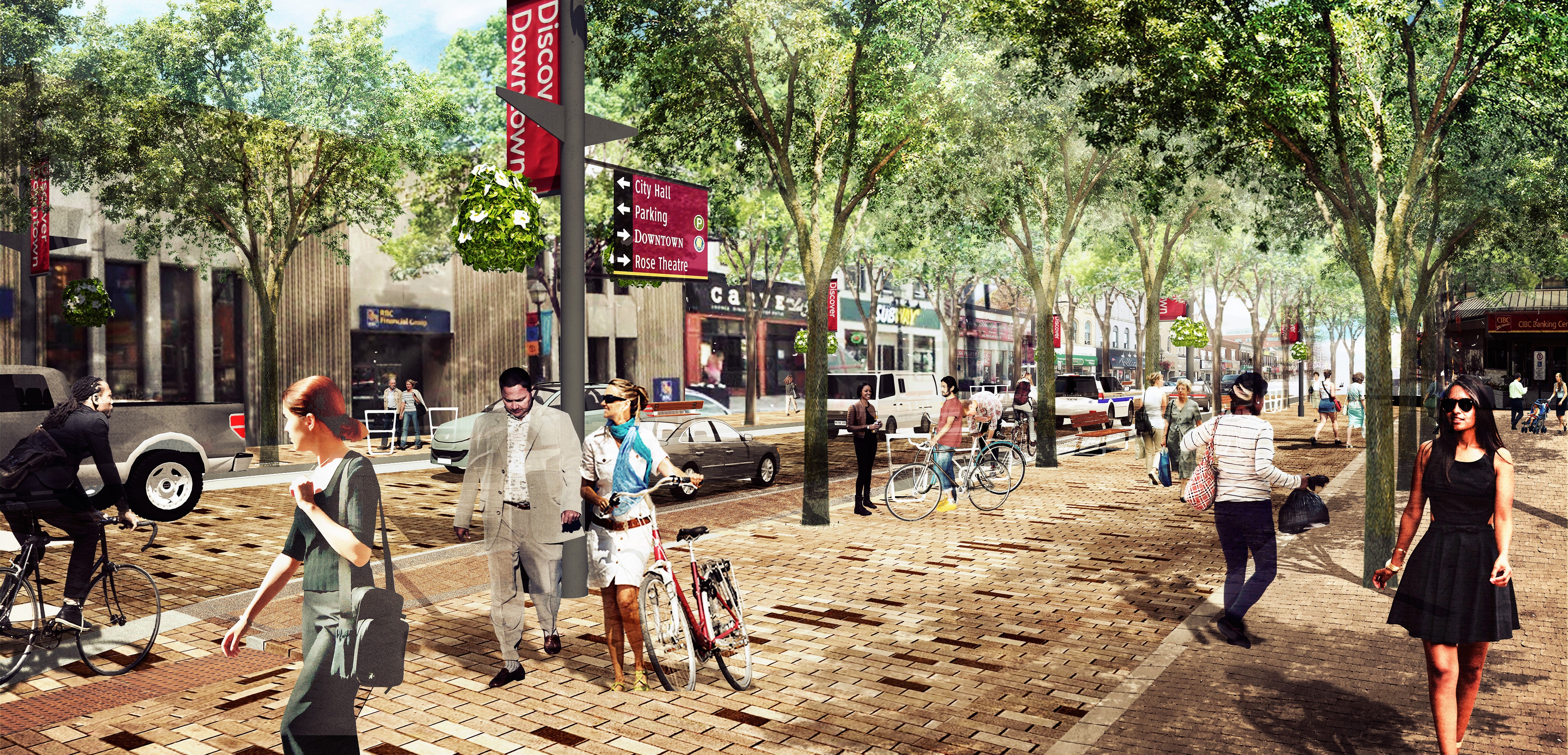
A rendering of the Downtown Reimagined project.
But council put it on hold.
The road closures forecasted to last upwards of four years as work proceeded, were also put on hold. The problem was increased costs (some bids on the project have skyrocketed to as high as $73 million), and there were fresh uncertainties about unresolved tunnel issues below the streets.
These tunnels were built in the 19th century to help divert the Etobicoke Creek which runs below the streets. The city doesn’t know where the tunnels are, and if by tapping into them, it might impact or even ruin the buildings above ground. It’s a wicked conundrum that has new Mayor Patrick Brown mystified. He asked why this problem wasn’t taken care of when the project was planned years ago, long before his new council took office in early December. He’s not the only one.
Kicking the can down the road irks Rick Evans of CCV Insurance (32 Queen Street West). The long-time owner and current executive with the Business Improvement Association (BIA), said the city should have fixed its infrastructure issues a decade ago, not now. In late 2018, just before the decision to halt work was announced, he slammed the city for its inaction. “We’ve watched it [the downtown] rot for 20 years,” he said.
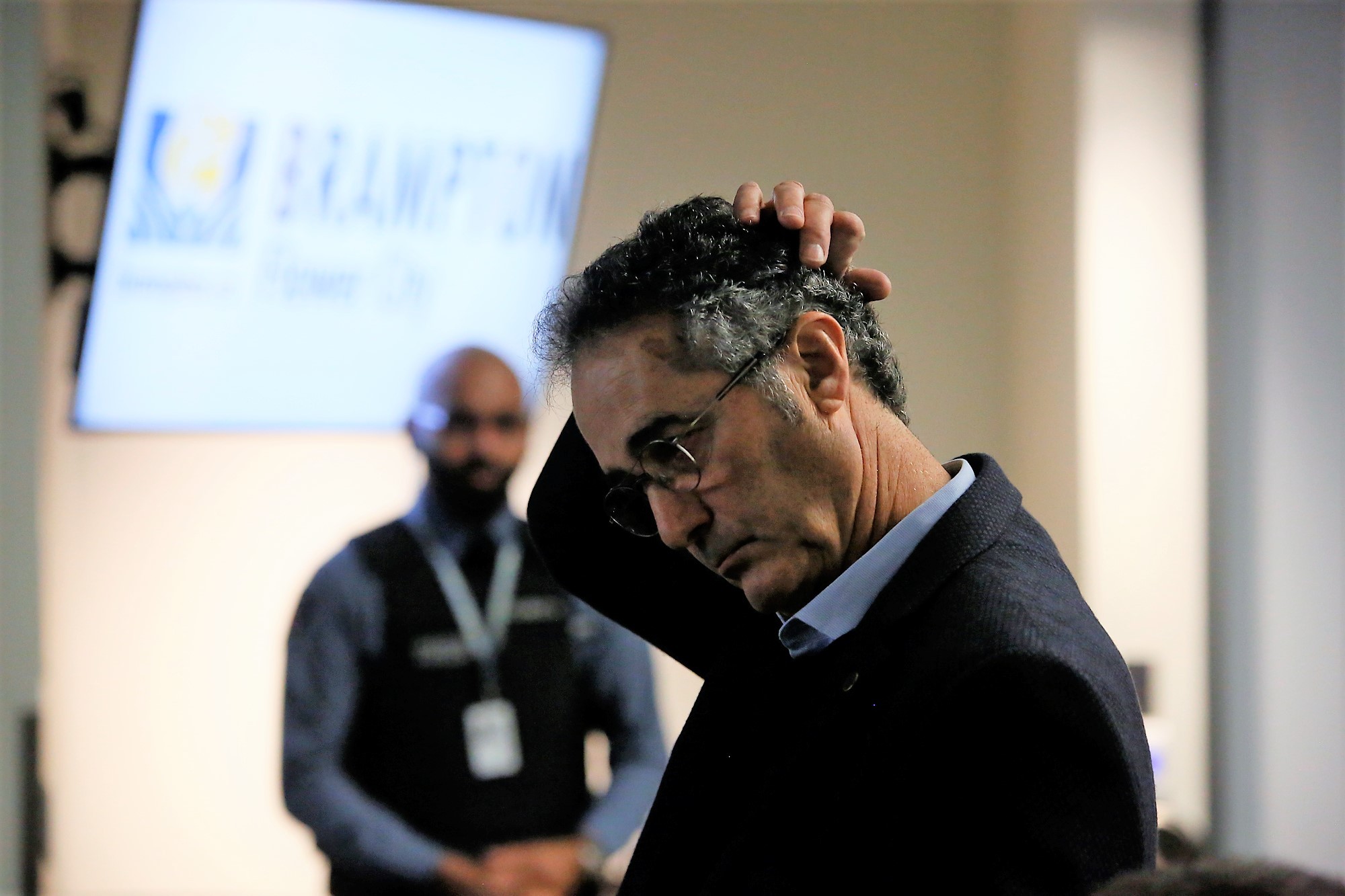
Rick Evans expressed his frustration at a recent city council meeting.
The stoppage was a second batch of bad news for a city still reeling after the $90 million promised it by the provincial government to bring an expansion of Ryerson University to the downtown core, was cancelled in October by Premier Doug Ford.
Both cancellations put Brampton’s aspirational 2040 Vision in peril, a futuristic plan to recreate the growth model, from one of suburban sprawl to dynamic urban built form attracting white-collar employers and highly educated cosmopolitan citizens that gained input from 13,000 Brampton residents and was trotted out last year as a chance to propel Canada’s ninth largest (and fastest growing) city into the future.
“For a lot of the retailers and newcomers to this city, [the news] is depressing,” says Custodio.
While some downtown shop owners might welcome a pause on ripping up the streets for at least three years, and turning downtown into a construction war zone, Custodio isn’t one of them. He’s what Greenberg calls “a disruptor,” and it’s these forward-thinkers who are most needed now to help cities in this post-industrial age. Custodio knows Reimagined Downtown will prep the city-centre for other initiatives, like a proposed light rail transit line along Main Street.
It’s all about serving the needs of the next generation, including his daughter, he says.
So, what is the path ahead?
Custodio remembers Greenberg’s hopeful speech in Brampton and wonders why there was no political will then – using the city’s rich heritage buildings as the catalyst for future development – to ensure our future.
To turn old scrub land and buildings that have moved past their best-before date, into greenbelts and modern-day marvels, is urban design 2.0.
It doesn’t mean Brampton has to look to Canada’s biggest city for renewal ideas, either. If the BDDC served one purpose during its failed 10-year run to grow the core components of the downtown, it provided a forum for urban thinkers to discuss ideas with the public.
At a 2010, AGM, Rob Regier, executive director of economic development for Kitchener, was invited to the city, and also made a presentation. He was charged with re-doing its moribund downtown core. It, like Brampton, was post-industrial, land-locked, and sported many pre-Confederation buildings. They were both tired and rundown. Regier did such an outstanding job, he is now commissioner of planning, development and legislative services with the Regional Municipality of Waterloo.
The graduate of the University of Winnipeg, with a masters in regional planning from the University of Waterloo, oversaw Kitchener’s renaissance. He says it was all about being “substantial without pretense.” Much of it involved putting the city under construction for years while a new LRT line was built through the core, connecting it with its sister city, Waterloo. Turning old buildings like The Tannery into glittery and functional retail and housing icons took time, but the results were stunning. It didn’t hurt that the city received $265 million in federal funding to help.
The LRT has completed the connectivity between the city and the two nearby universities, Waterloo and Wilfrid Laurier. It makes it easier for residents to get around or even travel to other communities, including links to Pearson International Airport. The city’s old Victorian-era factories are now chic, livable spaces, and a special Economic Development Investment Fund (driven by a 1.2 percent levy) created jaw-dropping buildings like the Accelerator Centre, and the U of Waterloo School of Pharmacy.
Custodio can only look on the results with envy, and confusion.
Why was the Davis Courthouse (currently being expanded) on Hurontario not built in the downtown core as a part of an urban renewal plan? Why was the hockey rink that once housed the city’s junior club, the Battalion, and now the Beast, built in the middle of nowhere, on Kennedy Road? Why isn’t the new Peel Memorial healthcare centre connected to the downtown core? While the Rose Theatre and Garden Square have added some luster to the downtown, there has been no follow on.
The lesson learned in forward-thinking cities is to put public and even private buildings in the right place. The lack of office buildings in Brampton is a stunning example of how a core is allowed to shrink away. While Kitchener’s office space booms, and development sprouts up along its new LRT line, Brampton watches.
Toronto has plans to re-do another urban eyesore and create an 8.5 hectare "signature park," named Rail Deck Park, that will cover the railway tracks between Bathurst Street and the Rogers Centre. This multi-billion ‘Central Park of Toronto’, “is the best thing that we can do for future generations," said Mayor Tory, announcing it two years ago. It’s part of the city's TOcore project, a response to rapid intensification of its downtown, which has placed mounting pressure on physical and social infrastructure. The city is choosing how it will grow.
People like Custodio say Brampton also has a choice.
In Mayor Patrick Brown’s inaugural speech at the Rose Theatre in early December, he said it was way past time the city stopped “thinking small.” Fixing its fundamentals is the first stage in attracting new business (and tax revenues) through a revamped economic development office. It’s hoped a rejuvenation project like the “Riverwalk” will move urban renewal forward.
Downtown Brampton lies within the Etobicoke Creek floodplain. Provincial policies around hazard management restrict the type and amount of development that can occur there. It’s hoped the area’s flood risk can be mitigated and it will become sustainable and resilient. The Riverwalk project recently received $1.5 million in funding for its environmental assessment by the federal government, and mitigating the flood risk could unlock the potential for urban growth and development.
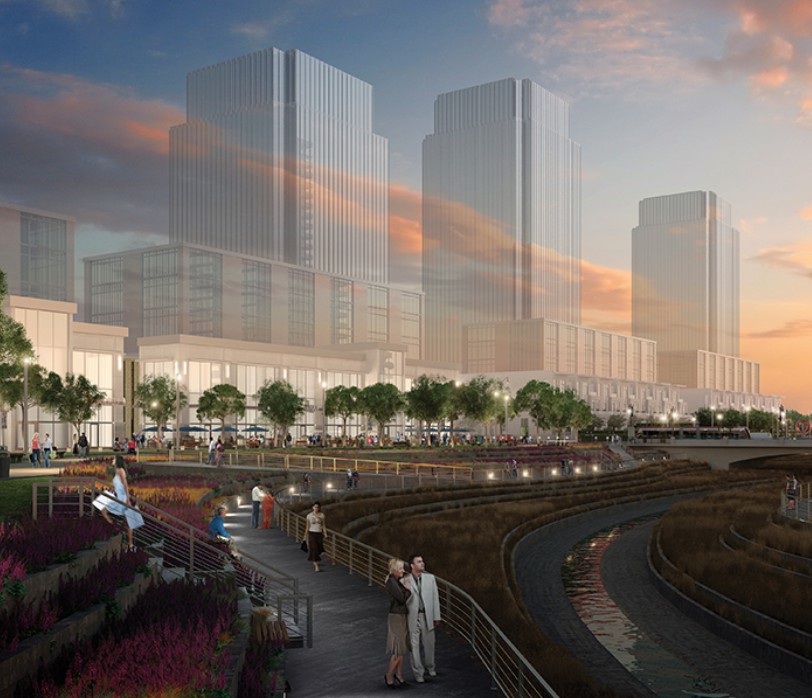
A rendering of the Riverwalk project.
The key word here is “could.”
The EA follows a formal process of reviewing the alternative solutions through an environmental, social and economic lens, to determine the most suitable solution. The eventual cost to build the infrastructure for a proper diversion to alleviate cresting waters could be between $150 and $250 million.
Custodio is tired of aspirational game plans that never propel the city forward. There’s still no all-day, two-way GO train service, and the city’s tax mix is lopsided – weakened by too many single-family homes that negatively impact paying off future infrastructure needs.
Custodio’s photo studio has been in the downtown since the early 1990s when he and his father’s photography studio moved from Toronto. With a new city hall, the coming Rose Theatre and expansive new underground parking the downtown was on the ascendency then, and there were zero vacancies. The Custodios had to set up shop on a side street until their present location became available.
He remembers a vibrant and eclectic core of eateries, retailers and plenty of foot traffic.
In fact, Brampton’s downtown was so bustling almost thirty years ago, says Custodio, a delegation from the Orangeville BIA travelled here to study reasons for its success. They used it as a model to re-do their own downtown – now one of the most vibrant in the province.
Like Brampton, it had an elegant mix of historical buildings and new retail.
While Kitchener and Orangeville and other cities flourished over the years, Brampton has stalled – and “lost its beauty,” says Custodio.
He says there was no political will to change, and over time as new projects were built to revitalize the core (city hall, its recent expansion, the Rose, a new bus terminal), nothing worked.
Even the formation of the BDDC (the first of its kind in Canada, and charged with attracting new development), piddled off into clichéd irrelevance after a decade.
Four city councillors sat on its board, perhaps making it more of a political body than a business generator, and today, Custodio thinks the downtown has fallen into a sinkhole, both physically and metaphorically.
The Reimagined project’s cancellation, for now, has created a funk, he says, that is felt by the downtown retailers, and the new regime now in charge at city hall.
He says anyone happy about the postponement because of the loss of business the work would have caused, is stuck in the past.
While the revitalization of Kitchener caused great disruption, and ended the dreams of some retailers, the future looks bright for those that survived. Others cities have gone through the same process in the past, and the town of Oakville will begin work on its downtown early this year.
Custodio is buoyed by news that Algoma University is moving into some of the empty space in the Dominion building currently housing Starbucks. He’s also encouraged that council will look at the future growth through the lens of economic development. He likes the noble intent of creating a “Brampton advantage,” but how the new mayor defines it is open to interpretation.
Kitchener’s revival has created high-paying jobs in many innovative sectors, and Brown says Brampton wants to replicate that over the next 20 years. But the economic plan won’t work unless “we fix our fundamentals.”
That includes fixing the downtown streets, both above and below.
Brampton’s new council recently voted to build any future LRT line into the downtown core along Main Street. It has not given up working with Ryerson to bring a university to the city, and current initiatives include a new Centre for Innovation, Ryerson’s Chang School of Continuing Education (two courses on cyber security starting in early ’19), a pilot incubator hub (expected this spring), and the expansion of Algoma.
The old bones that Greenberg talked about – the PAMA buildings on Wellington, the Dominion building, the Heritage Theatre, and other historic sites around the core, plus the Rose – are enhanced by Garden Square and Gage Park. The city’s DNA can, if used properly, drive change in the 21st century.
The business stalwarts in the downtown core, like CCV and Custodio’s, want to see action to reimagine the city – to make it more competitive, and beautiful.
The conundrum of using old buildings to create new opportunities, is not lost on urbanists like Greenberg.
What might be considered ugly or anti-people, like the Gardiner Expressway, has to be seen in a different light. The opportunities are enormous.
The feeling of many at the moment is that Brampton is not being proactive.
The projects holding the city back from future growth, need to be fixed – even if the costs are large.
Greenberg likes being a disruptor, and remaking the underbelly of the Gardiner Expressway is the kind of thinking that has been lacking in Brampton for generations.
If the downtown is tired and substandard, it doesn’t mean it has to be that way in the future.
Since Greenberg’s address in Brampton, things have gotten worse. The Susan Fennell and Linda Jeffrey regimes failed to institute change to revive the downtown. The baton has been passed to Brown and council. Money is tight, and infrastructure costs are rising. Vision 2040 looks like a document that might gather mothballs unless the city embraces a go-forward development model that rejects old ideas and embraces a strategy blending old and new. And a fiscal plan to get more commercial and high-density residential properties built so that the much larger tax revenues from such growth starts to flow into the city’s coffers.
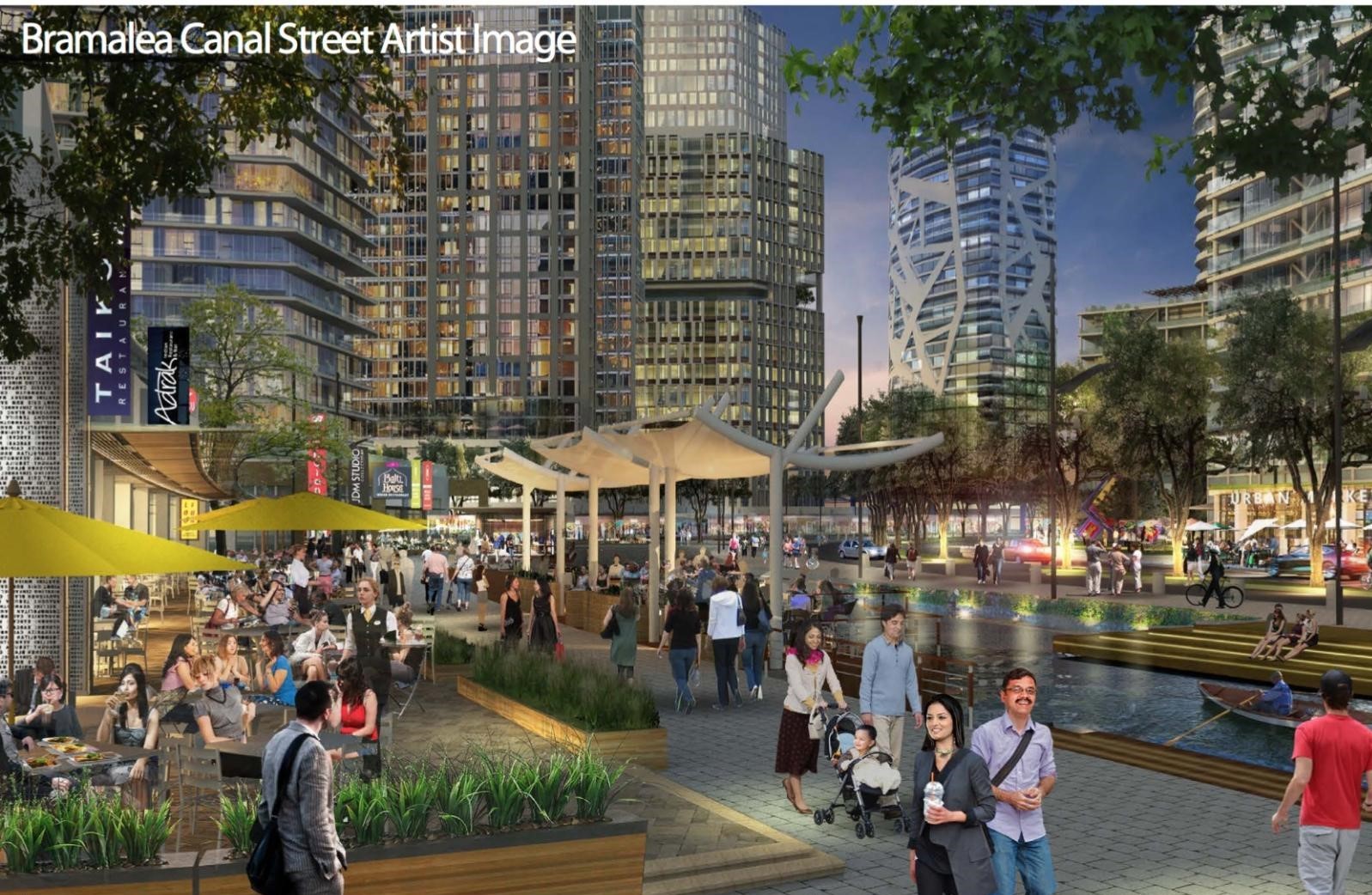
Rendering of the 2040 Vision plan.
Boarded up buildings are dead zones for tax collection. Sprawling subdivisions requiring vast infrastructure and expensive service delivery aren’t sustainable. Locating public or even private buildings in far off locales, doesn’t cut it anymore. Targeting the downtown core creates vibrancy, and future tax dollars.
Custodio says a city’s soul is defined by its downtown, and it’s imperative that Brown and council make revitalization a “core component” of their four-year mandate.
It’s time to do the fixes. It’s time to be proactive. The longer we wait to make changes, the more it will cost us in the long run, he says. Sure, some retailers won’t survive the re-do. This is what happened in Kitchener. But most did, and more will now want to be there to take advantage of a powerful downtown.
The old-new orthodoxy that makes cities both big and small, dynamic and people-friendly, recognize the power of retrofitting. This is what is now happening in the Spadina Avenue catch basin, and it is more than possible in Brampton – if there is the political will.
In Greenberg’s address to the crowd at the Rose Theatre, he said few communities in Canada have the beautiful and aged buildings that dot our downtown core.
Custodio doesn’t mind waiting for the end-result of the Reimagined downtown. But he doesn’t want any more urban experts passing through the city and telling us we have great potential.
“This city has lost its identity,” he says. “It’s now time to get it back.”
Submit a correction about this story


